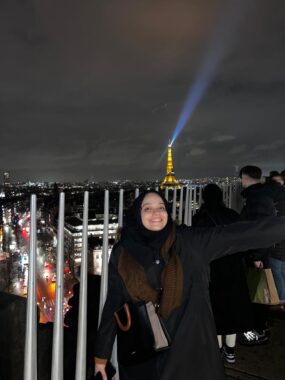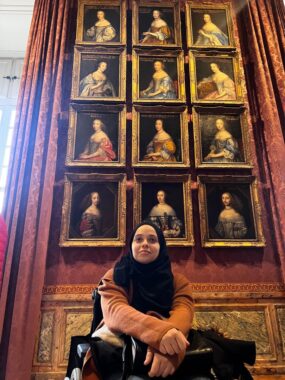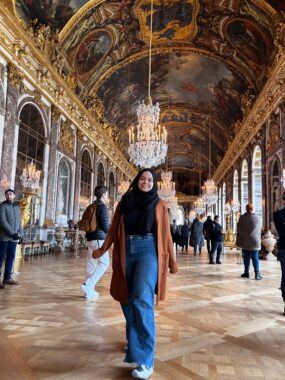Traveling to Paris was a dreamy adventure, despite my MG
Although I faced some hurdles, much of the city was accessible for me

Traveling was one of my biggest fears after my myasthenia gravis diagnosis in 2019. If I got tired at home easily, what would navigating an airport and exploring a bustling city feel like?
A few years ago, when my father suggested my sister and I visit a European country before our Italian visa expired (I will write more about this soon), I chose Paris. Who could resist? Plus, given the historical ties between Algeria, where I live, and France, I’m more familiar with the French system and language.
Before the trip, which we took in January 2023, I worried. Could I explore all of Paris with an invisible disability? I dreamed of visiting the Eiffel Tower, the Palace of Versailles, and as many museums as possible, but the question lingered: Was it possible for me?
Disability-friendly Paris

Columnist Sarah Bendiff was freezing but triumphant at the top of the Arc de Triomphe in Paris. (Photo by Dounia Bendiff)
Thankfully, my health was stable, and Paris was surprisingly accessible. Not only are most monuments equipped with wheelchairs for visitors, but free and priority access is guaranteed for disabled individuals and their companions (my sister, in this case).
After contacting various monuments, I learned that proof of disability — regardless of the issuing country — is accepted. I had my Algerian government-issued disability card translated into French, and that little document opened so many doors for me.
The Louvre: My journey began at the iconic Louvre Museum. Admission was free for my sister and me, and although I didn’t need it, there was a free wheelchair rental service inside. The staff was incredibly kind, granting me access to secret elevators to enhance my experience. They even allowed my sister and our friend to join me.
I couldn’t explore the entire museum, but the art I saw moved me to tears — not just because of its beauty, but also because of the care and consideration I experienced.
P.S. There are disability-friendly restrooms hidden away, so don’t hesitate to ask the staff. They’re welcoming, and even the restrooms are stylish!

Queen Sarah is seated in her borrowed wheelchair in Versailles, France. (Photo by Dounia Bendiff)
The Eiffel Tower: This was more challenging. At the time I visited, there was no priority access, but I received a 50% disability discount, which was a pleasant surprise. Visiting at night was a great decision, as there was only a 30-minute wait, and the view from the top was pure magic.
The Arc de Triomphe: This was another highlight of the trip. Our admission was free, and instead of climbing 284 steps, the staff guided me to an escalator. Reaching the top felt like stepping into a fairy tale.
Versailles: By the time I arrived at the Palace of Versailles, I was utterly exhausted. While one agent seemed skeptical of my condition, they let me skip half the line. Another kind agent managed to lend me a wheelchair, for free, even though I hadn’t reserved one. My sister pushed it, making me feel like royalty!
Throughout my trip, I wasn’t shy about walking when I felt up to it, which sometimes surprised onlookers. Their reactions to a wheelchair user suddenly standing up were priceless!
Challenges and takeaways

“Not all wheelchair users are paralyzed.” Sarah poses at the Palace of Versailles in France. (Photo by Dounia Bendiff)
Of course, not everything was perfect. Transportation was a significant challenge — much of Paris’ metro system wasn’t wheelchair-friendly, and I struggled to find elevators. Navigating the airport also involved a few altercations with agents doubting the validity of my disability. However, staying firm and calm and presenting my translated disability card always resolved the issues (especially since I speak French fluently).
Despite these hurdles, my trip to Paris was dreamy and unforgettable. The city’s accessibility, the kindness of many staff members, and the careful planning I put into the trip made it all possible. My advice to others is to look up everything online before jumping on the airplane!
Traveling with myasthenia gravis taught me that adventure is achievable with the right mindset and preparation. I’m grateful for the resilience this condition has given me and for my ability to embrace new experiences.
Pray for me to visit more countries soon. I can’t wait to report back and share more stories with you!
Note: Myasthenia Gravis News is strictly a news and information website about the disease. It does not provide medical advice, diagnosis, or treatment. This content is not intended to be a substitute for professional medical advice, diagnosis, or treatment. Always seek the advice of your physician or other qualified health provider with any questions you may have regarding a medical condition. Never disregard professional medical advice or delay in seeking it because of something you have read on this website. The opinions expressed in this column are not those of Myasthenia Gravis News or its parent company, Bionews, and are intended to spark discussion about issues pertaining to myasthenia gravis.







Mary Lynne Knighten
Sara, your resilience and sense of adventure are inspiring!